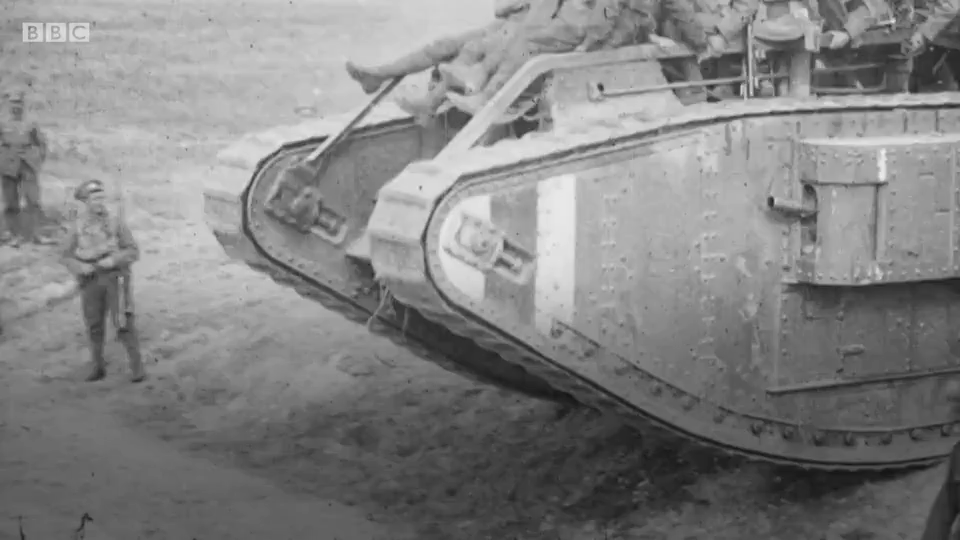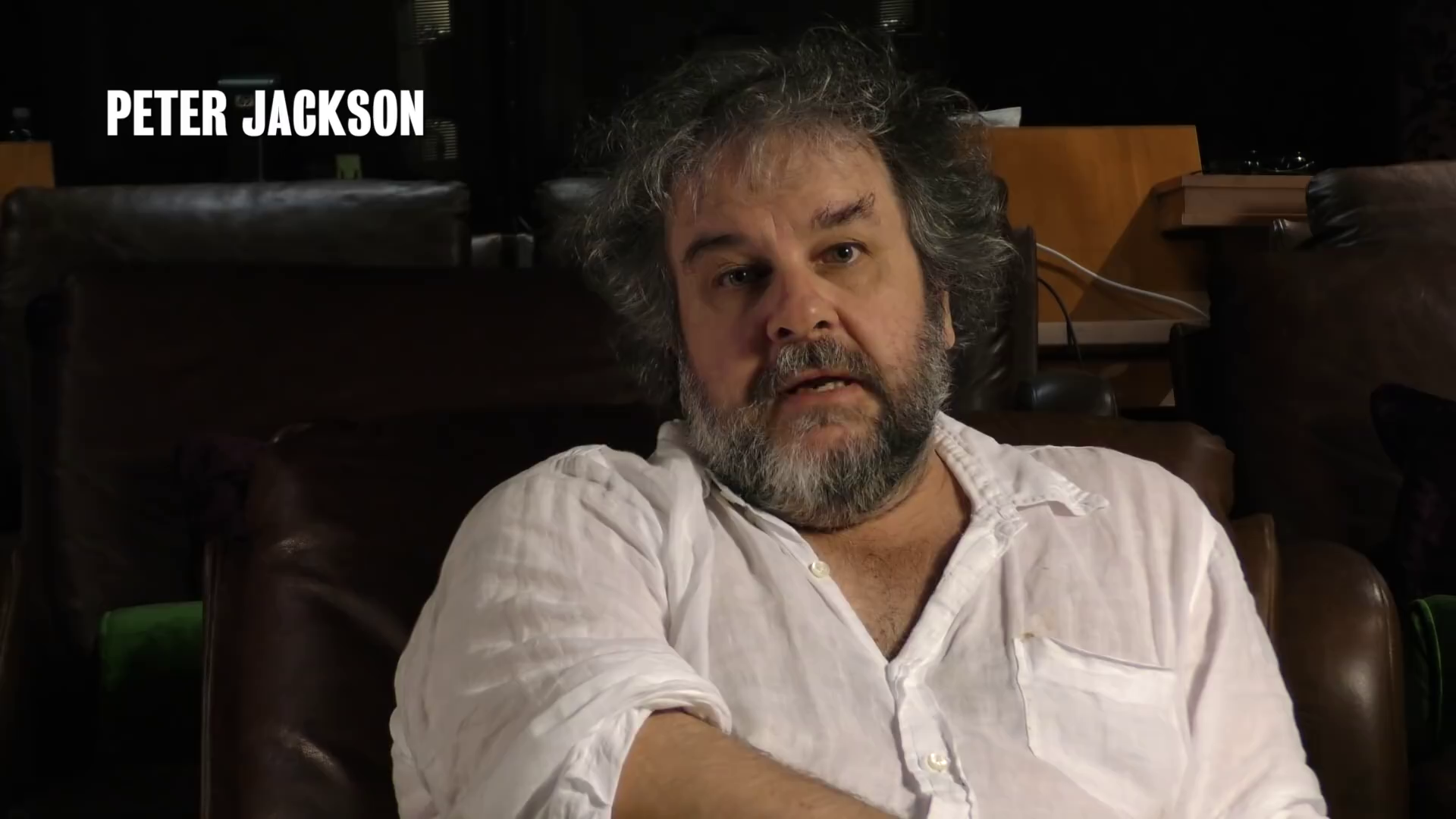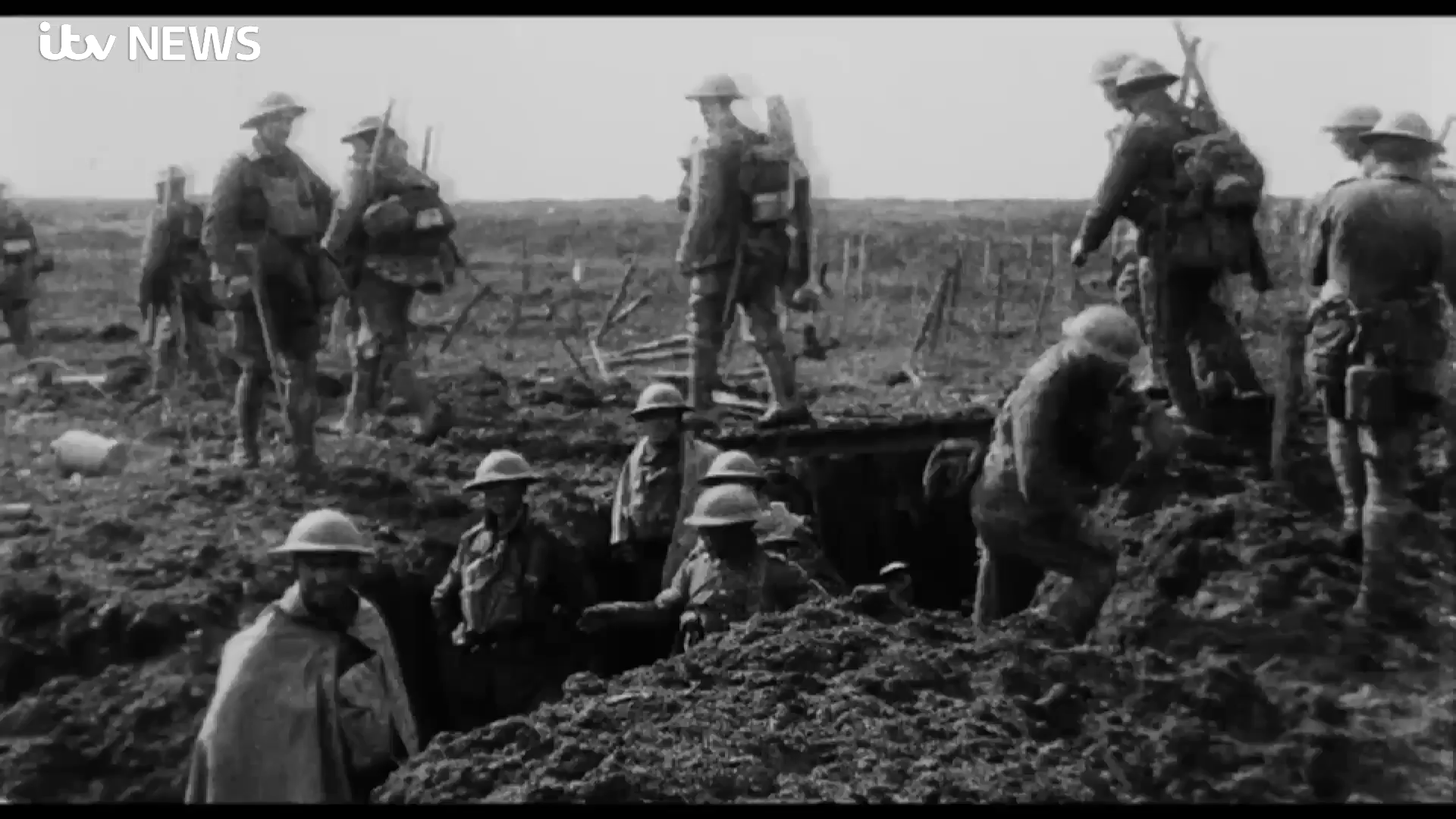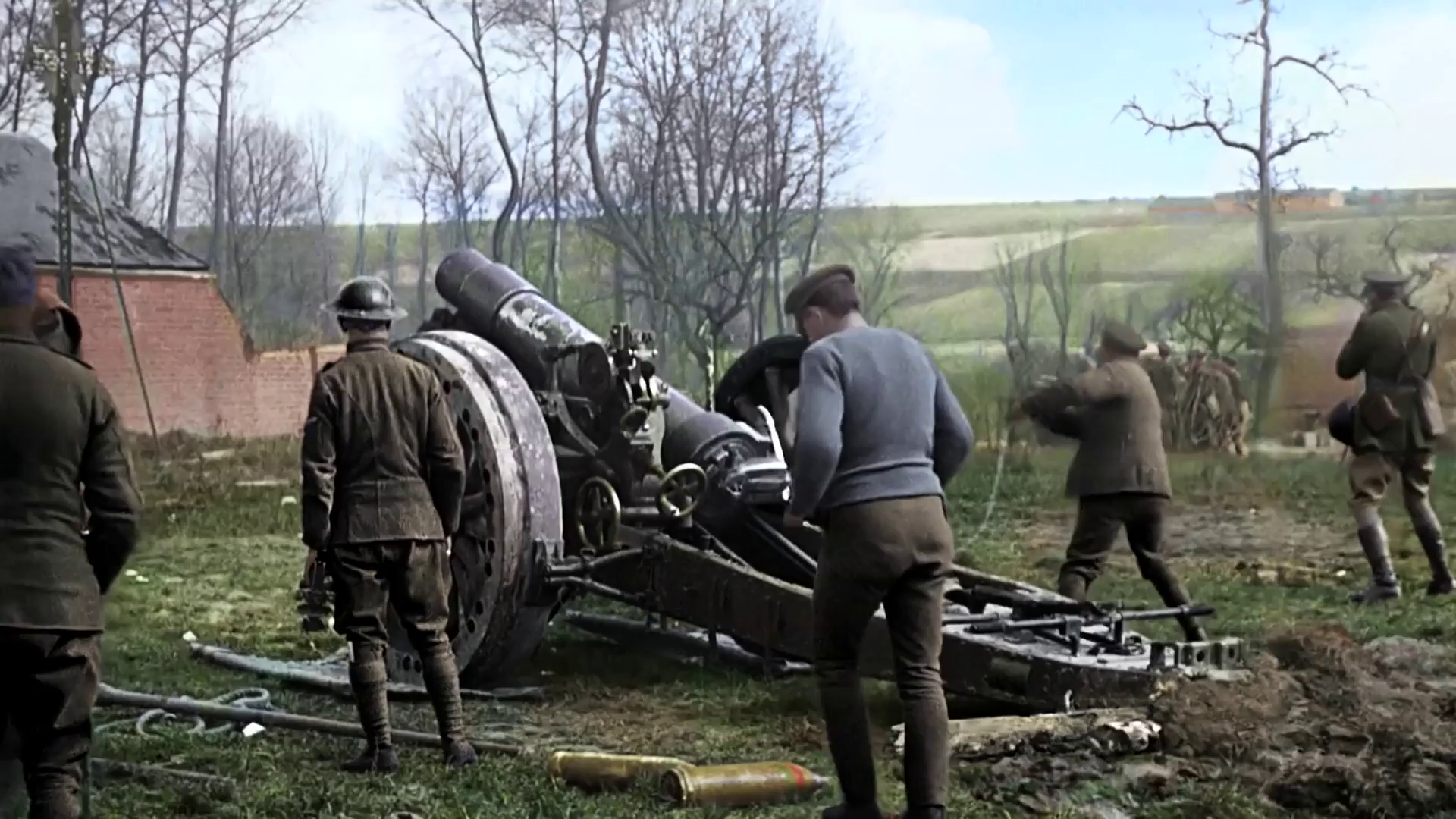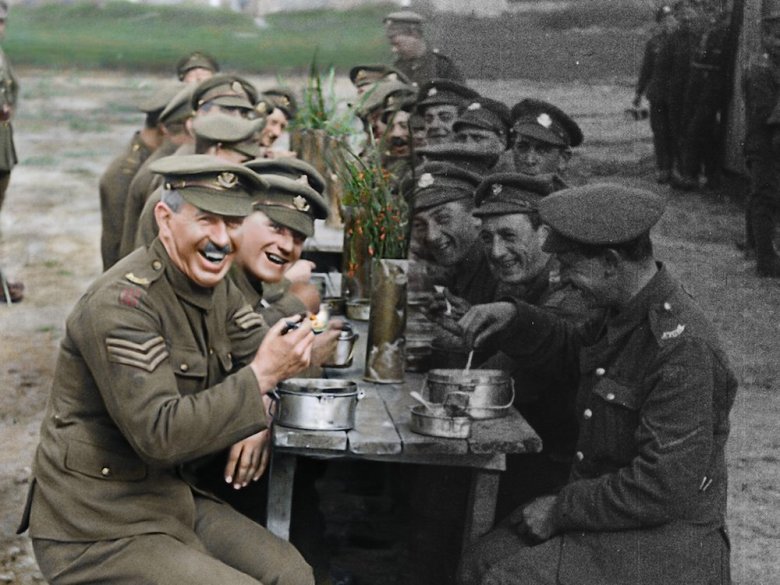
Photo from the Peter Jackson WW I documentary "They Shall Not Grow Old"
print Print...
(from AFP Relax News) – Black and white silent film footage from World War I has been transformed by Oscar-winning director Peter Jackson into a 3D colour movie to mark the centenary of the end of the [war to end all wars].
The legendary filmmaker painstakingly restored and coloured hours of archival footage and paired it with historical veterans’ interviews and a special effects soundtrack, to bring the war back to life in an unprecedented way.
This included using lip readers to decipher what soldiers were saying in the century-old silent films and inserting new matching audio recorded with actors. [Forensic lip readers, who usually work with the police determining what people say on silent security camera footage, were able to decipher the words spoken long ago on film.]
The film — “They Shall Not Grow Old” — will be unveiled for the first time at the London Film Festival next week, and simultaneously screened in different venues across Britain.
“I was absolutely gobsmacked by the time we’d finished restoring this stuff, I’d had no idea that it could be done so well,” Jackson told AFP ahead of the release. “People have restored film before, but they haven’t really restored it to the Nth degree.”
The project began four years ago in the office of Diane Lees, director general of Britain’s Imperial War Museums (IWM).
Aware Jackson was a WWI “addict” whose grandfather fought in the conflict, Lees pitched him the idea of collaborating for the centenary of the conflict as part of “14-18 NOW”, a programme of events to commemorate the landmark.
“They wanted me to use their archival footage, but use it in a way that was surprising,” recalled Jackson, a 2004 Oscar-winner for the last film in his “The Lord of the Rings” trilogy. “I’ve looked at a lot of World War One documentaries my entire life and I thought ‘what the hell can I do with this?’ It’s not been done before.”
Working in his native New Zealand, the filmmaker used his own production company and other restoration specialists around the world to begin transforming more than 80 hours of old footage into 3D colour film.
The team encountered myriad challenges, from scratches and missing frames to film that had shrunk over the century and in some cases was more than twice as slow as modern footage.
“The film became very emotional,” Jackson said of the restoration process. “The faces of the men just suddenly come to life… I’m suddenly looking at this like I’ve never seen it before. Just looking at their faces and their expressions, they become real human beings — the nuances, the little things.”
[“It’s not the story of the war,” said Jackson. “It’s the story of the human experience of fighting in the war.”‘
Jackson listened to over 600 hours of audio interviews with veterans — recorded by the IWM over the years and by the BBC in 1964 — to use as narration over the footage.
“There’s been lots of documentaries made on the First World War…and I just decided for this one to strictly just use the voices of the guys that fought there,” said Jackson. “So no historians, no narration, no nothing.”
[In order to recreate the color as accurately as possible, Jackson studied pictures of crowds on the internet and used collections of WWI uniforms as a reference point. The narration for the film is provided by real veterans. Jackson combed through recordings from 1964 of 120 men who fought in WWI.] Meanwhile, the team also sourced other elements of the soundtrack, such as the sound of artillery firing and shells and mines exploding.
As he plotted the documentary’s course Jackson said he tried to shake other war documentaries he had seen from his brain in a bid to produce something wholly original.
What has emerged is “a story of the men who fought in the western front.”
“It gave me an appreciation of being alive at the time that my grandfather was alive,” Jackson said. “The fact that I can look at something that he saw, I thought ‘wow this is pretty extraordinary’.”
Despite the horrors of war on display, a more nuanced picture emerges of the men — and many teenagers who had pretended to be aged 19 to be able to fight — without self-pity.
“These guys went through hell but they didn’t feel sorry for themselves,” noted Jackson.
Lees, of the IWM, said the museum was not only benefitting from the 99-minute film, but from more than 80 hours of restored footage now returning to its archives in 4K digital format.
“It’s an astonishing piece of work,” Lees added of the collaboration, which she hopes will educate a new generation on the war.
“When you see it in colour, in 3D, and the voices of the veterans over the top telling their narrative it is incredibly powerful for new audiences.”
[Created to honor the centenary of the First World War armistice, on November 11, 1918, “They Shall Not Grow Old” brings to life the reality of war on the front line for a whole new generation. The footage has been colorized, converted to 3D and transformed with modern production techniques, making the hundred-year-old footage feel like it was shot today.]
From Agence France-Presse Relax News. Reprinted here for educational purposes only. May not be reproduced on other websites without permission from AFP.
Questions
1. a) Who is Peter Jackson?
b) Following a request from Britain’s Imperial War Museums, what did Peter Jackson do to commemorate the 100 year anniversary since the end of World War I?
2. Describe the steps Jackson took to make the documentary.
3. How does Mr. Jackson’s explain the difference between his documentary and the many that have previously been made about the First World War?
4. The documentary is 99 minutes. What is Mr. Jackson giving to the museum as well?
5. What did Mr. Jackson note about the soldiers who fought in WWI?
6. Jackson told the BFI about the documentary “I wanted to reach through the fog of time and pull these men into the modern world, so they can regain their humanity once more – rather than be seen only as Charlie Chaplin-type figures in the vintage archive film. By using our computing power to erase the technical limitations of 100 year cinema, we can see and hear the Great War as they experienced it.”
Watch the interviews with Mr. Jackson, and the movie trailer. What 2-3 words would you use to describe Mr. Jackson? Explain your answer.
CHALLENGE QUESTION: Without looking it up, between what years was WWI fought? Who were the major players on each side? When did the U.S. enter the war? What is Armistice Day? What do poppies have to do with WWI?
Resources
Watch a BBC report:
Peter Jackson describes the film:
Watch British ITV News report:
Watch the movie trailer:
Daily “Answers” emails are provided for Daily News Articles, Tuesday’s World Events and Friday’s News Quiz.
